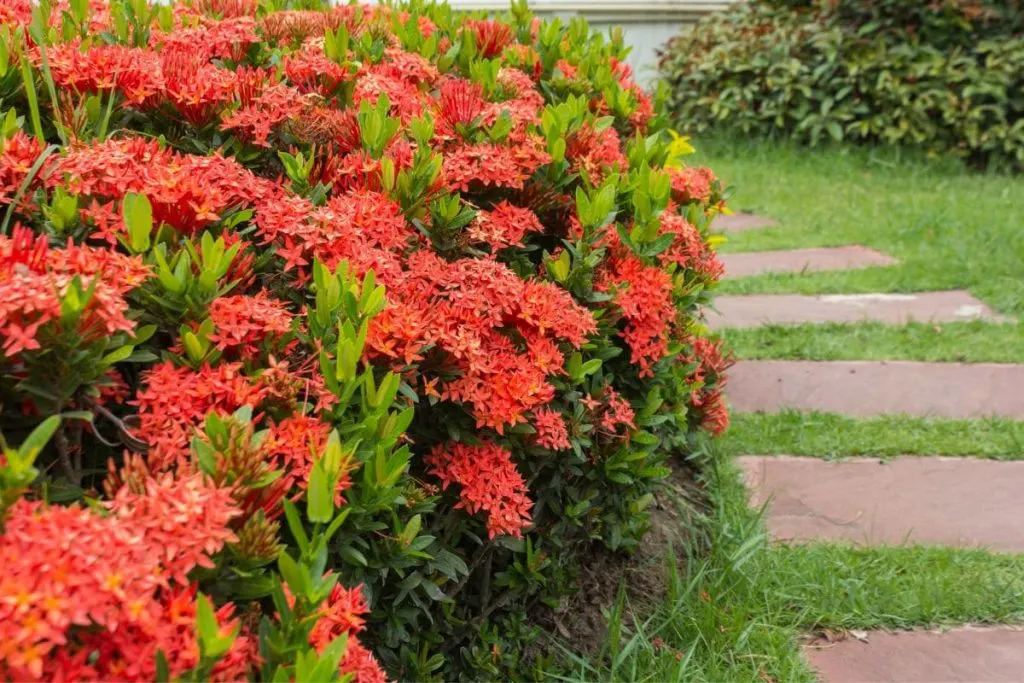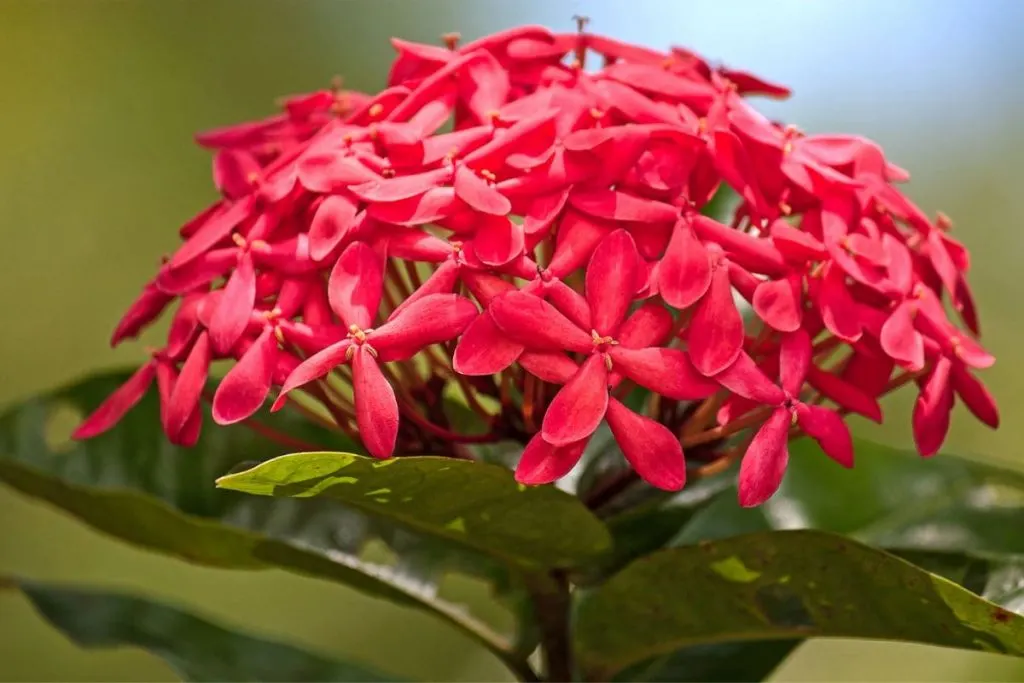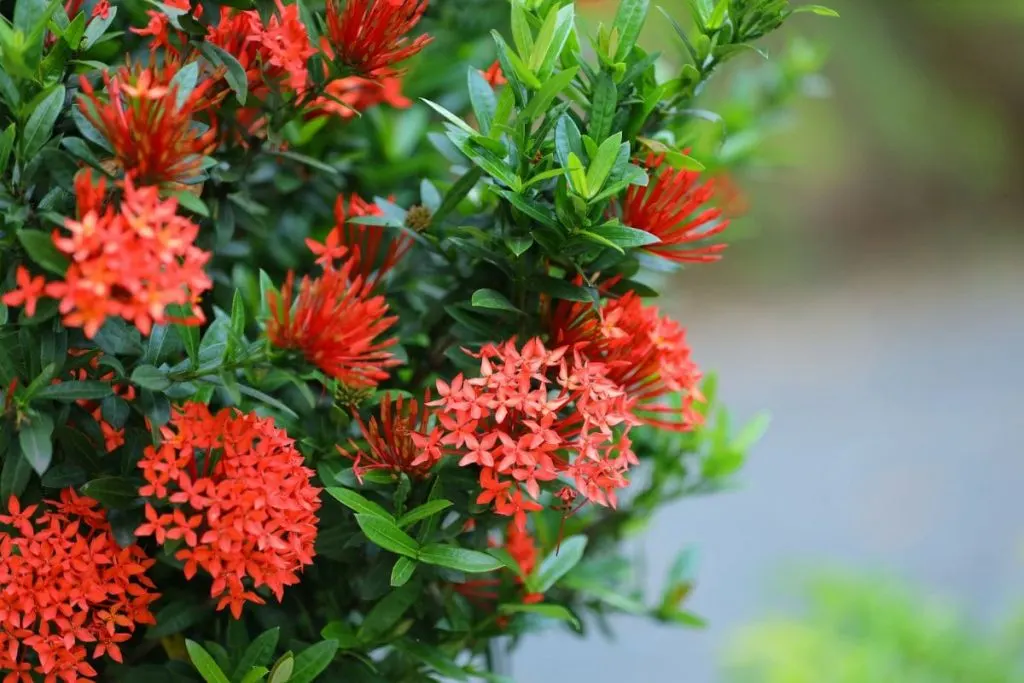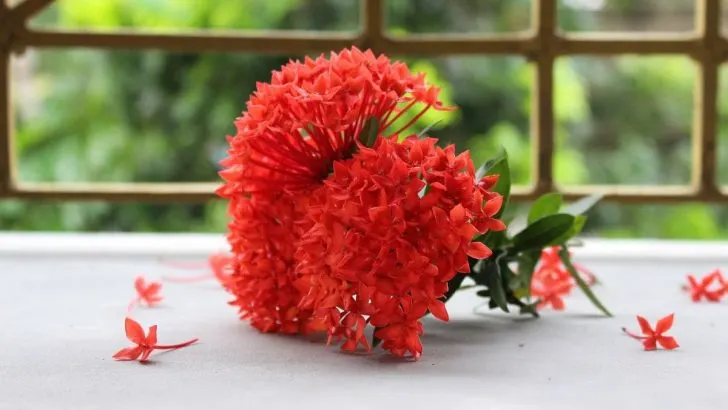In today’s article, we will talk about Ixora species and their care guide. If you are a fan of large flower clusters or want to introduce such plants to your garden or terrace, then this article is the perfect choice for you.
They are excellent as a container plant, you can plant them in open ground or next to some other plant. Today we will present to you the simple growing habits of Ixora plants.
They often call it the flame of the woods, iron tree, jungle flame, jungle plant, and many other names that are all accurate due to its interesting and unique look.
If you want one in your yard, let’s learn all about the plant’s soil, its light needs, and more. In early spring, you might have this exact plant thriving in your garden. Let’s start then.
About Ixora Plants

Before learning about its care guide, maybe it’s best to show you what botanical features this plant has. Let’s learn some simple facts and information about Ixora tropical plant in the section below.
Native habitat: India, Sri Lanka, and Southeast Asia,Family: RubiaceaeBotanic name: Ixora coccineaCommon names: scarlet jungle flame Flower shape: rounded, red flowers Leaf shape: rounded form Toxicity: nontoxic plant USDA zone: 9 and above Is Ixora A Perennial Plant?
Ixora plant is a tropical perennial plant. Its colors variate from dark purple, red, white, yellow, and pink. Everyone can definitely find a beautiful variety for themselves. The Ixora plant is also one of the perennials that bloom all summer. You will surely fall in love with it.
Where Do I Plant Ixora?
Ixora coccinea thrives best in full sun conditions combined with soil moist. These acid-loving plants need a bit of acid soil to healthily bloom and organic matter in the early springtime too.
They are often attacked by the scale insects, so make sure to check your soil and leaves every time you water the plant.
Care Guide For Ixora Plants

Below we bring you everything you need to know about the care guide of the Ixora plant. If you’re ready to grow or re-grow Ixora once it drops leaves, we present you with a simple care guide.
Learn all about the common pests, growing new roots, what to do if moved indoors, and some other simple maintenance things that even many gardeners don’t know.
Light Conditions
In order for your Ixora plant to grow completely happy, you will need to combine different types of light for different seasons and hours of the day.
It sounds complicated, but if you really want your plant to get its vibrant orange tones or its leaves to remain beautiful bright green leaves, you won’t avoid an extra 5 minutes of work, I’m sure.
Direct sunlight is the best option in summer and spring in the afternoon hours when the sun is weaker, and it will certainly feed your plant with the necessary energy.
In the afternoon when the sun is at its zenith, it is enough for the plant to have moderate light ie bright light conditions.
If you are propagating the plant, it is especially important that the plant is in direct sunlight until the new seedling sprouts. Partial shade and shade in general are not recommended in such conditions.
Water Needs
Especially when planting a new growth or preparing a new growth in a different pot, well-drained soil is crucial.
The top layer of the soil always has to be dry, and the deeper one, of course,e but the surface especially before watering your plant again.
Most people think that more water will encourage its compact size to grow even bigger, but that is simply a myth with every plant you stumble upon.
More water for your plant doesn’t mean better growth, it means damage and maybe even death for your plant.
In its winter time, definitely reduce watering. If you’re planning to cover your plant with a plastic bag or a tent for plants to survive the winter, definitely avoid much watering since condensation creates perfect conditions for pests to occur.
The plant grows in a tropical USDA zone, and unlike other zones, these plants need lots of water in the heat-wave period but also checking regularly the soil before doing so.
Type of the water doesn’t matter. Rainwater, tap water, distilled water, it’s your free choice.
Soil Type
When it comes to its soil, choose between organic matter and peat-based soils. The pH ratio should be between 5.5 and 6 since we already mentioned that this tropical plant loves acidic soils.
pH level above 6.5 causes dull foliage color, droopy appearance, and similar issues you don’t want to face.
Avoid black soil, perlite, and clay soil, because in this type of soil there will certainly be no progress. Adding compost right away is also a good idea for Ixora plants.
Temperature
The plant is a tropical plant that does not like temperatures below 60 F. The best ratio that suits it is between 60 and 80 F.
It does not tolerate cold or relatively-cold temperatures at all, and a change in temperature is immediately reflected in its appearance.
If you plan to transplant the plant and bring it inside during the winter, you must do it gradually.
Avoid drastic changes from outside where the temperature is 50 or 55 F, which is certainly cold for the plant at the start, to rooms with a constant temperature of 65-70 F.
Can Ixora Plant Survive Winter?
Ixora is a tropical plant and it is one of the plants that can’t stand cold temperatures at all.
If you want to see your Ixora blooming next spring as well, make sure you cover it up with something during winter.
Once they struggle with cold temperatures, you’ll notice dull foliage color. After cold temperatures, the Ixora plant just isn’t the same anymore.
Another amazing tropical plant you can bring into your home during winter time and will look even better inside is Anthurium pendulifolium.
Humidity
Like any other tropical plant, Ixora plants like higher humidity levels in the air.
Humidity up to 70% suits them, and if you grow it indoors and you don’t have that much humidity, buy an air humidifier that will surely solve the problem.
Humidity below 50% can easily affect its appearance, and it will constantly seem to you that the plant will die at any moment due to a lack of humidity.
Moisture is what makes their stems and leaves firm, presentable and shiny.
Fertilizer
The best fertilizer choices for the Ixora plant are 10-10-10 or 5-10-10 fertilizers. Avoid using ordinary household fertilizers.
Fertilize the plant in early spring or early summer, never after August because of the short dormancy period, and of course, never in winter.
It is good to buy soil rich in organic substances at the very beginning. That is one of the things that will keep your plant blooming. Other things you’ll find out about below.
How To Keep Ixora Blooming?
By amending the soil, you’re making a really good first step. Add a bit of compost in its blooming season and water a bit more regularly. Be careful with the water to avoid overwatering.
Choosing the right fertilizer for your Ixora plant will help it a lot in its blooming season. Don’t add too much water in their booming time, that might do the opposite thing.
Propagation
The best way to propagate the Ixora plant is by cuttings. Do it like this:
- cut around 6 inches of semi-wood branch,
- remove the leaves from the branch,
- prepare the soil or water if you prefer more where you’ll put the branch,
- place the cuttings in a position where they will get lots of direct sunlight,
- if propagating in water, watering isn’t needed of course, if propagating in soil, water around every 5 days, but just a little bit,
- in about 4 weeks, you should see new growth,
- repot the plant in its new pot and grow as a regular Ixora plant.
Pruning
You can prune this plant when you see problems with the leaves and stem or when the end of its flowering period is to immediately prepare the plant for the next season properly.
We always advise you to use sharp scissors or a knife and to cut at an angle of 45 degrees.
Pests And Diseases Of Ixora Plant

One of the most common issues of Ixora plants is sooty mold. When you notice mold on your plant, it means that aphids or scale insects are also closed and are already “hatching” in your plant’s soil.
This also happens when people buy small space humidifiers for extra small rooms. When you’re not winding out your room a lot, there is excess water in the soil. Add humidity to do that you have a formula for creating a perfect environment for aphids or scale insects.
If you want to get rid of them, try using insecticidal soap (do deep soaking with it) and avoid your plant’s dripping wet soil. This is the most important-good rule you have to remember.
Insects love water (excess water) so make sure you always do a finger check before watering, especially in the growing season when most people overwater their plants. Good drainage isn’t overwatering, it’s watering correctly between sets of watering.
Final Thought

Today we learned everything you need to know about the Ixora plant, especially about its care guide.
The cheerful and lively colors of this plant will beautify your green garden and bring a little tropical look to it.
The plant is not difficult to maintain. With the little reading you’ve already done, you’re already halfway to making this plant your own and making it the highlight of your garden.
Shall we repeat it one more time? Direct sun until about 12 o’clock in the afternoon, bright light in the afternoon, slightly acidic soils, organic matter such as compost, and pruning as necessary and at the end of the flowering season.
That would be all for today, see you tomorrow with more similar topics.


